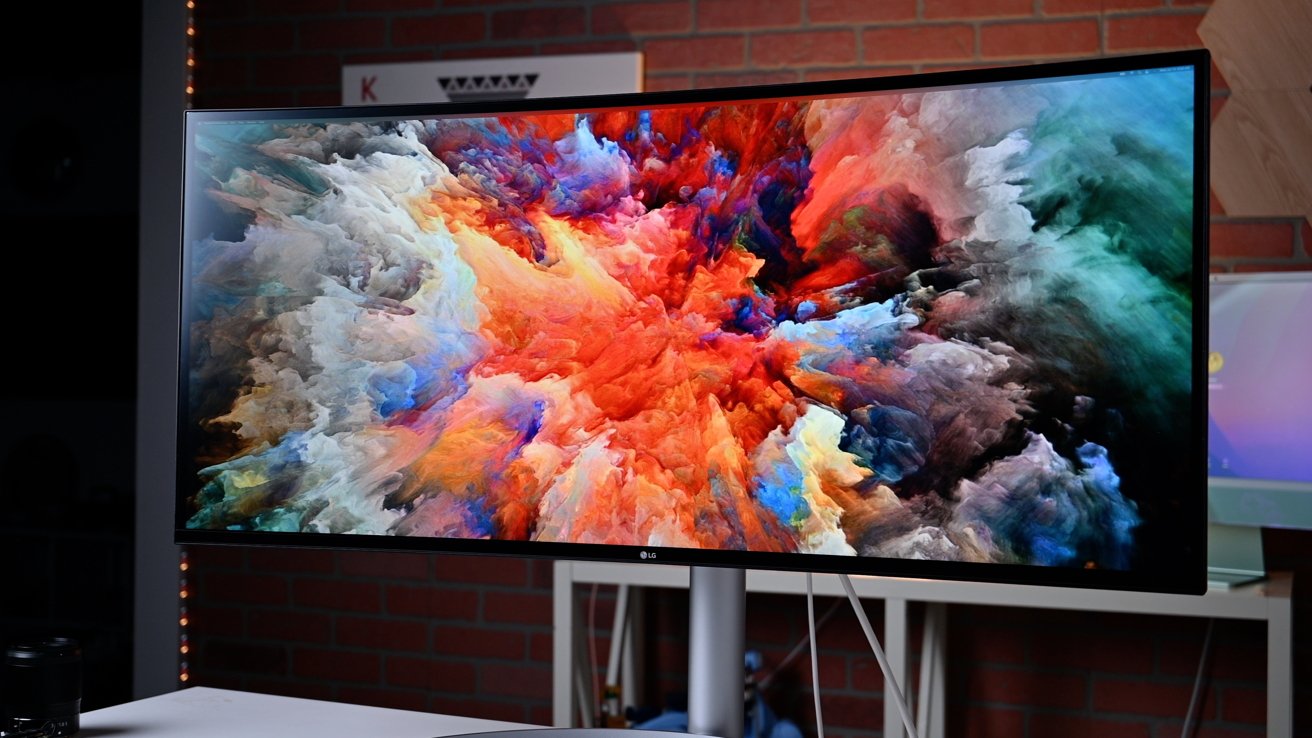Apple's next Studio Display could be curved and very secure
Apple has been researching how to make privacy filters to prevent anyone but the user from seeing what's on their curved screen -- but Apple has never made a curved screen.

LG curved ultra-wide Thunderbolt Display
You can read too much into Apple's thousands of patent applications, but it's unlikely that the company would research a technology with no intention of using it. The six credited inventors on a new patent application did not cook this up during their lunch hour.
That's especially unlikely as the new application is "Privacy Films for Curved Displays" -- and a version of it was already granted by the US Patent Office in 2023. So Apple is not only exploring the idea of curved screens, it's iterating on the idea.
Except the patent application is not about making a curved screen, it's about one specific thing to do with using them privately. Apple proposes putting a covering layer over the display.
It's like a polarizing film in that it means light can only come out in one direction. So while the user is sitting at the right spot in front of the screen, they see the full retina-quality and full brightness of the display.
But anyone trying to look from even slight to their left or right, will either see nothing at all, or more likely a blurry image. This won't stop anyone standing right behind the user and peeking over their head, and that might actually be a serious issue if someone's seat across the office is positioned just so.
"A privacy film may have a light-blocking layer that is interposed between first and second transparent substrates," says the patent application. "The opaque portions may be shaped to ensure light from the display is directed only to the primary viewer of the display."
Apple's proposal is more sophisticated than affixing an extra coating or layer to a display, however, because the company wants this privacy to be controllable.
"Changes in the operating mode of [the] display to implement angle-of-view restrictions... may be made based on user input or may be made automatically by control circuitry," continues the patent application. "Control circuitry may, for example, use information such as content sensitivity information to determine whether or not content that is being display[ed] on [the] display should be displayed in normal mode or privacy mode."
"If, for example, a user is viewing a movie, the movie may be displayed in normal mode," says Apple. "In the event that a private message such as an incoming text message is detected, [the] display may be placed in privacy mode, thereby ensuring that the content of the text message will not be inadvertently revealed to unauthorized parties."
The patent application concentrates on the complexities of adding such an optional, adjustable privacy filter to a curved display in particular, but it does also include regular, flat monitors.
So if this proposal ever becomes a shipping product, it's at least possible that it will come to flat displays like those on iMac and MacBooks.
It's interesting that Apple is continuing to look at ways of changing how screens display information, because recently it's been looking at replacing screens instead. Or rather, to have it so that a screen appears, say, completely blank unless you are the owner and you are wearing Apple Vision Pro.
Note that a further patent, with the same name and by the same inventors, was granted on September 10, 2024. It could be an admin update or some kind of clerical change as there's no immediately obvious difference in the text, but it suggests that Apple is continuing to pursue the idea.
Read on AppleInsider

Comments
So yeah, this is now in the realm of “possible,” I’d say. Retina 10240x2880, 32:9.
As an owner of the Apple 32" XDR monitor Apple please bring back the big screen iMac in a XDR enclosure before the end of the decade.
Clearly William does not have a lot of experience working with intellectual property in corporate America. This statement is absurd and uninformed. Companies file patent applications all the time for ideas they have no intention of actually using, for protective (and frankly, anti-competitive) purposes. They do it so that any of their competitors, who in the future may also have the same/similar idea, will encounter roadblocks to bringing a new product to market. Companies like Apple encourage their employees to submit ideas for patents, no matter how viable they would be in a true product; and reward employees with cash bonuses when the legal team files the application and again if it is granted. I have colleagues who crank out dozens of patent ideas per year - they sit around thinking about crazy new "inventions", talk to the lawyers, and a week later an application is filed. So no, do not read too much into any Apple patent application, because the vast majority are from one of these random idea factories.
https://support.apple.com/en-us/105126 Apple should offer this feature on all future iMacs no excuses and the critics should criticize them loudly if they don’t.